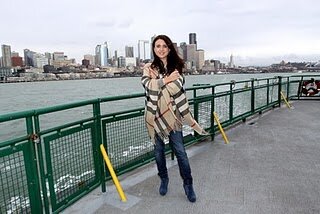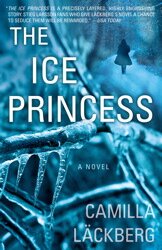Apparently one of the things that people are prone to do in Scandinavian countries, perhaps for amusement during those long winter nights, is speculate about murdering each other. If millions now know the name of Lisbeth Salandar-creator Stieg Larrson, he’s just the tip of the Nordic mystery iceberg.

Just yesterday, April 5, Swedish mystery author Camilla Läckberg was at the Seattle Mystery Bookshop. It was an 18-hour day, she says on her blog, where she also gives a shout-out to Ann Rule.
Läckberg has been hailed as the successor to fellow Swedish bestseller Larrson, though as the Minneapolis Star-Tribune points out, her first novel was published “before Larsson’s ‘Millennium’ books saw print.” It is true, though, that her books are being translated into English by Steven T. Murray, who also translated Larsson for us.
This Friday, the Swedish author of the the Kurt Wallander mysteries, Henning Mankell, appears at the Seattle Central Public Library to read from his tenth Wallander book, The Troubled Man. You may have been watching his work, rather than reading it, as KCTS has been running the Kenneth Branagh series. (There’s also a Yellow Bird film series starring Krister Henriksson as Kurt Wallander that’s now available on DVD.)
Arnaldur Indriðason is not visiting us this week, to my knowledge, but he’s very popular locally, as you’ll discover if you try to check his books out from the library. He’s also gotten the film treatment: Jar City was Iceland’s 2008 entry for Best Foreign Film at the Academy Awards (“strange and absorbing” says the New York Times, and you can watch it online at Netflix. You’ll meet Inspector Erlendur Sveinsson, who is something of a tale of woe investigating other tales of woe. In his off-time, he sits at home reading histories of Icelanders who vanished in storms, presumably dying of exposure.
 Each of three are more of the “every life matters” school than the puzzling-solving category. Läckberg’s The Ice Princess stands out in this company for its more traditional introduction of likely suspects and unearthing of red herrings, but it is untraditional in other, fresh ways. The book’s protagonist is Erica Falck, who’s back in her hometown Fjällbacka following her parents’ death, when an estranged friend from childhood is found dead as well, an apparent suicide.
Each of three are more of the “every life matters” school than the puzzling-solving category. Läckberg’s The Ice Princess stands out in this company for its more traditional introduction of likely suspects and unearthing of red herrings, but it is untraditional in other, fresh ways. The book’s protagonist is Erica Falck, who’s back in her hometown Fjällbacka following her parents’ death, when an estranged friend from childhood is found dead as well, an apparent suicide.
Falck, a biographer, has a Nancy-Drew-like inquisitiveness, and Läckberg arranges for her to be offered the chance to write a biography in memory of her friend, which serves as cover for her investigation. (Seamless plotting is not usually the strong point of a writer’s first novel, and it’s passable here.)
Where Läckberg shines is all the ways Falck is a real person, making sense of a real death. She’s no superhero, à la Lisbeth; she’s not a trained investigator. She’s more of a snoop who happens to have local connections. Along the way, you get a substantial dose of Fjällbacka history (Läckberg’s real-life hometown), insight into how summer residents decorate their homes versus long-time residents, musings into the difference between small town and Stockholm life, and disruptions of the investigation by an abusive husband (he’s English, just saying).
Along the way, she meets detective Patrik Hedström, who’ll reappear in later novels, and the book chronicles their romance as well. It’s not usual in crime thrillers to take time out for regrets at breaking a diet, detailed preparations for a date (“she washed under her arms and sent a silent prayer of thanks that she had shaved her underarms when she showered this morning”) or for lightly sexy moments like this:
She bent over to take his plate, making sure to lean forward a bit more than usual. She intended to make the most of the trump cards she had. Judging by Patrik’s face she had just shown herself to be holding three aces. So far her Wonderbra had proved to be worth the 500 kronor she had invested. Even though it had left a sizeable dent in her pocketbook.
(Before turning to crime fiction, Läckberg was an economist.)
Mystery piles on top of mystery here, and Falck turns what looks like a slim premise into nearly 400 pages that it’s hard to put a bookmark into. I’m interested to see how her style has developed over her seven books, as this first is only marred by a reliance on stock phrases (things are “crystal clear” and people “put on airs,” there’s even a “look of naked horror”), telling instead of showing (“Erica’s voice was inquisitive”), and a tendency for people to talk alike. (As it’s a translation, there may be some Murray in all this.)
Overall, it’s a refreshing take on the genre. As much as I love Wallander and Erlendur, there’s a Job-like propensity to suffer in the lives of both workaholics. Wallander’s emotional sensitivity and declining health and family drama are of a piece with Erlendur’s death-haunted past and struggles to deal with the substance abuse issues of not one but both of his children. (Which is not to mention the larger sociopolitical dramas that often form the backdrop of their mysteries.) If either of these guys caught a break, it would be a shattered femur. Falck has lost her parents, true, but Läckberg isn’t arguing for special case status. Erica is going to find out the truth, but on her own terms:
It was people–their relationships and psychological motivations–that she was interested in; she thought that was something most crime novels had to give up in favor of bloody murders and cold shivers running down the spine.